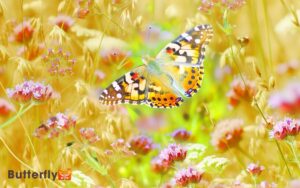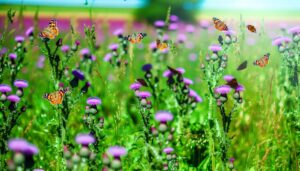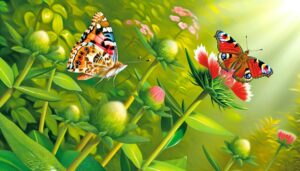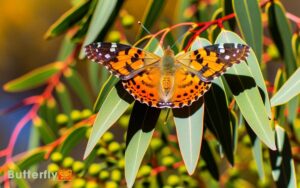Painted Lady Butterfly Cocoon Fell: Essential Tips!
When a painted lady butterfly cocoon falls, it disrupts important metamorphic processes. Immediate actions include verifying the cocoon’s structural integrity and checking for tears or discoloration.
Secure the cocoon with non-toxic adhesives or thread suspension. Environmental disturbances like wind or rain, improper attachment, and predators often cause falls. Observing for changes in color or fluid leakage can indicate the pupa’s health.
Providing a stable, predator-free environment that maintains humidity and temperature is essential for recovery and prevention.
Successful reattachment enhances the chances of a healthy butterfly emerging. Detailed insights on safeguarding and supporting the cocoon’s development follow.
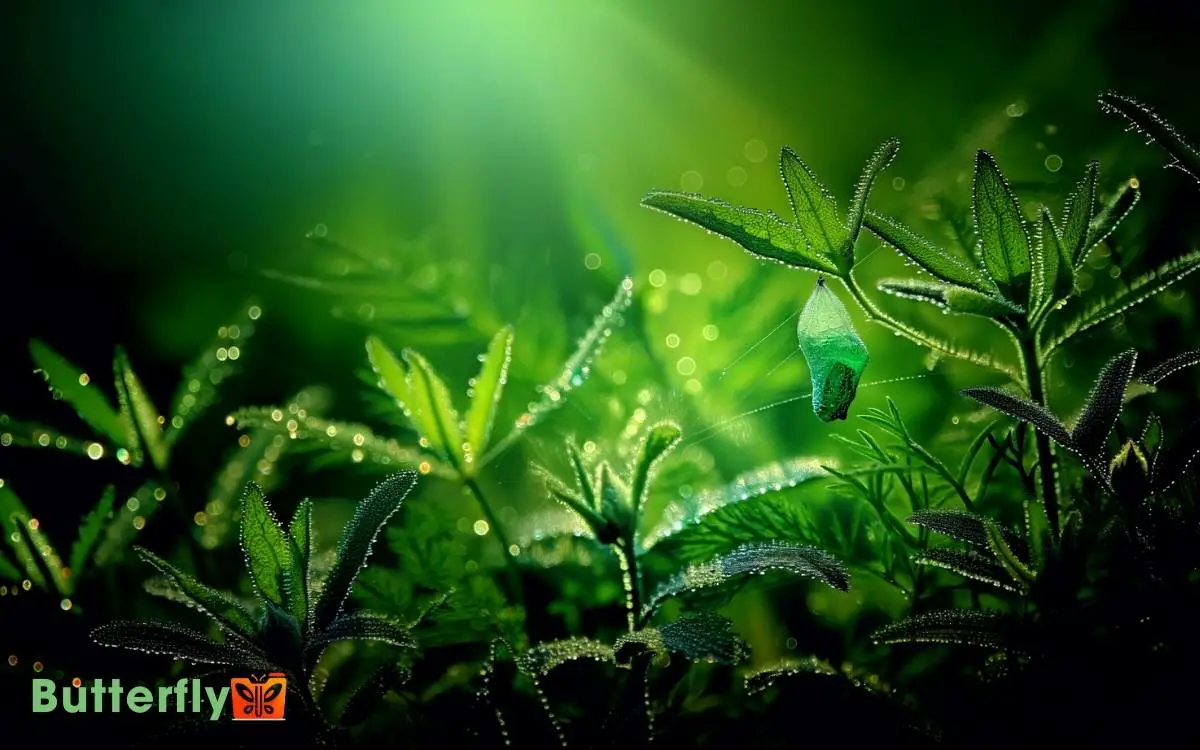
Key Takeaways
Understanding Butterfly Metamorphosis
Metamorphosis in butterflies, including the Painted Lady, is a complex biological process involving distinct stages: egg, larva, pupa, and adult. Each stage is critical for development.
The egg, often laid on host plants, hatches into a larva (caterpillar) that feeds voraciously to accumulate energy reserves. This larval stage undergoes multiple molts, shedding its exoskeleton to grow.
Upon reaching a certain size, the larva forms a pupa, or chrysalis, initiating metamorphosis. Within the pupa, cellular reorganization occurs, transforming the caterpillar into an adult butterfly.
This process, governed by hormonal changes, showcases intricate physiological and biochemical transformations.
Understanding these stages is essential for grasping the complexities of butterfly development and the factors influencing each stage’s success.
Anatomy of a Painted Lady Cocoon
The Painted Lady cocoon, also known as a chrysalis, showcases a remarkable structure designed to safeguard the transforming pupa.
It features a tough outer layer that shields against environmental hazards and predators. This exoskeleton, composed of chitin, provides a rigid framework that supports the pupal development inside.
The chrysalis also exhibits a series of small, diamond-shaped windows called spiracles, allowing for gas exchange essential for respiration.
Internally, the pupa undergoes histolysis and histogenesis, processes that break down larval tissues and form adult structures.
- Chitinous Exoskeleton: Offers mechanical protection.
- Spiracles: Facilitate necessary gas exchange.
- Histolysis and Histogenesis: Transform larval tissues into adult organs.
These features safeguard the pupa’s survival and successful metamorphosis into a butterfly.
Common Causes of Falls
Environmental disturbances, such as strong winds and heavy rain, can dislodge a Painted Lady butterfly cocoon. Improper attachment spots, including unstable or smooth surfaces, also increase the risk of falls.
Additionally, predators and parasites may physically disturb or detach the cocoon during their attempts to reach the developing butterfly.
Environmental Disturbances Impact
Strong winds and heavy rains often dislodge Painted Lady butterfly cocoons from their perches, leading to premature falls and potential developmental disruptions.
Environmental disturbances have a notable impact on cocoon stability, primarily due to their delicate attachment mechanisms.
Such disturbances include:
- Wind Gusts: High-velocity winds can shear cocoons off branches, especially if the cocoon’s silk anchor is weak.
- Heavy Precipitation: Excessive rainfall increases the weight on the cocoon, causing detachment from its support structure.
- Temperature Fluctuations: Rapid changes in temperature may affect the integrity of the silk, making it more susceptible to breakage.
These environmental factors collectively pose risks to the cocoons, potentially hindering the successful emergence of adult butterflies, thereby affecting their life cycle and population sustainability.
Improper Attachment Spots
Improper attachment spots, often resulting from suboptimal surface textures or insufficient silk production, markedly contribute to the premature detachment of Painted Lady butterfly cocoons.
When larvae select surfaces that lack adequate roughness or are too slick, the silk anchor points fail to adhere securely. This less than ideal adhesion is exacerbated if the larvae produce insufficient silk due to nutritional deficits or environmental stressors.
Detailed observations reveal that smooth, non-porous surfaces like glass or metal are particularly problematic. Additionally, surfaces subjected to frequent vibrations or disturbances can further weaken the attachment.
Ensuring the best possible attachment involves monitoring the texture and stability of potential surfaces, as well as the health and silk production capabilities of the larvae, to mitigate the risk of premature detachment.
Predators and Parasites
Predators and parasites, by targeting vulnerable stages such as the chrysalis, greatly contribute to the detachment and subsequent fall of Painted Lady butterfly cocoons. These threats exploit the immobility of the chrysalis to gain nutrients or for reproductive purposes.
- Birds: Some avian species peck at chrysalides to access the developing pupae, causing physical damage and weakening their attachment.
- Wasps and Flies: Parasitic wasps and tachinid flies lay eggs inside or on the chrysalis. The emerging larvae consume the host, often breaking the chrysalis’s anchoring points.
- Ants: Ants can sever the silk pad that secures the chrysalis to its substrate while scavenging for food, leading to its fall.
Understanding these interactions highlights the ecological pressures on Painted Lady butterflies.
Identifying Damaged Cocoons
A damaged Painted Lady butterfly cocoon often exhibits irregular shapes, discoloration, or visible tears in the silk casing. These deformities can indicate compromised structural integrity, making it essential to scrutinize the outer layer meticulously.
Look for asymmetrical bulges, which may signal internal disturbances. Discoloration, particularly browning or blackening, can suggest fungal infections or parasitic infestations. Tears or perforations in the silk might result from physical trauma or predator attacks.
Observing the cocoon’s attachment point can also be revealing; a loose or broken connection to the substrate could indicate recent damage.
Identifying such signs early allows for timely intervention and potentially increases the likelihood of successful butterfly emergence without delving into developmental impacts.
Assessing the Impact on Development
When a Painted Lady butterfly cocoon falls, immediate assessment of potential damage and reattachment methods is essential.
Improper reattachment can exacerbate developmental delay risks, impacting metamorphosis and emergence success.
As a result, researchers must employ precise techniques to secure the cocoon and monitor for any signs of developmental anomalies.
Cocoon Reattachment Methods
To ensure successful butterfly development, researchers have explored various methods for securely reattaching fallen Painted Lady butterfly cocoons, evaluating each technique’s impact on the pupal stage and subsequent emergence.
Each method’s effectiveness is meticulously assessed through detailed observations and scientific accuracy.
Techniques include:
- Adhesive Reattachment: Utilizing non-toxic glues to reattach cocoons, ensuring minimal pupal disturbance.
- Thread Suspension: Employing fine threads to suspend cocoons, mimicking natural attachment and reducing stress.
- Pinning Method: Securing cocoons using pins, ensuring stability without damaging the pupae.
Researchers measure parameters like pupal health, emergence success rate, and morphological normalcy. These methods aim to balance stability with minimal interference, essential for ensuring healthy butterfly development.
Developmental Delay Risks
During the reattachment process, researchers meticulously monitor for signs of developmental delays, evaluating any deviations from normal growth patterns in Painted Lady butterfly cocoons.
They track developmental milestones such as pupal color changes, emergence timing, and wing expansion rates.
Any abnormalities, including delayed eclosion or incomplete metamorphosis, can indicate underlying issues.
Researchers also observe physiological stress markers like reduced weight gain and abnormal movement patterns. They employ morphometric analysis to compare cocoon structures with control samples.
Advanced imaging techniques, such as scanning electron microscopy, help identify microstructural defects.
By quantifying these parameters, scientists aim to understand the impact of cocoon displacement on developmental trajectories, ensuring they can mitigate any risks associated with such incidents.
Immediate Steps to Take
Carefully assess the condition of the fallen cocoon to determine any visible damage or abnormalities. Look for tears or punctures, changes in color, and any fluid leakage, as these can indicate critical issues.
- Examine the structural integrity: Check if the cocoon remains intact without any ruptures or significant deformities.
- Observe color changes: A healthy cocoon should retain a uniform color; any darkening or discoloration may suggest internal damage.
- Monitor for fluid leakage: Presence of fluid can indicate that the chrysalis has been compromised and may not support successful metamorphosis.
Document these observations meticulously to inform subsequent actions. Ensuring the cocoon’s viability is vital for the Painted Lady’s successful development into a butterfly. Immediate, accurate assessment can mitigate potential developmental risks.
Creating a Safe Environment
Creating a safe environment for a fallen Painted Lady butterfly cocoon requires meticulous attention to location, predator prevention, and humidity control.
One must select a site shielded from direct sunlight and extreme temperatures, ensuring stability. Additionally, barriers or enclosures can deter predators and pests, while maintaining ideal humidity levels supports proper development.
Choosing the Right Location
Ensuring the cocoon’s location is stable and secure is pivotal to preventing any disturbances that could jeopardize the butterfly’s development.
Selecting an appropriate environment involves several key factors:
- Temperature Control: Maintaining a consistent temperature between 70-75°F is vital to ensure ideal development.
- Humidity Levels: Aim for a relative humidity of 60-70% to prevent desiccation or fungal growth.
- Ventilation: Guaranteeing adequate airflow to facilitate gas exchange without causing drafts that might dislodge the cocoon.
A meticulously chosen location mitigates the risk of accidental falls, which can cause physical damage to the chrysalis.
Observing these conditions promotes a safe and conducive environment for the metamorphosis of the Painted Lady butterfly, thereby enhancing the likelihood of successful emergence.
Understanding these parameters is imperative for anyone nurturing these delicate insects.
Avoiding Predators and Pests
Protecting the cocoon from predators and pests is essential to safeguarding the developing Painted Lady butterfly. Predators like birds and spiders pose significant threats, while ants and parasitic wasps can compromise the cocoon.
To create a safe environment, place the cocoon in a mesh enclosure with fine netting, ensuring it’s elevated to deter ground-based pests. Regularly inspect for signs of infestation or damage.
Utilize natural repellents, such as neem oil, which are non-toxic to the butterfly but effective against pests. Additionally, maintain a clean environment to reduce the attraction of predators and pests.
| Predator/Pest | Mitigation Strategy |
|---|---|
| Birds | Mesh enclosure |
| Spiders | Fine netting |
| Ants | Elevated placement |
| Parasitic Wasps | Natural repellents (neem oil) |
| General Cleanliness | Regular inspection and maintenance |
Providing Proper Humidity
Maintaining appropriate humidity levels is essential for the healthy development of the Painted Lady butterfly within its cocoon. Insufficient humidity can lead to desiccation, while excessive moisture promotes mold growth.
To achieve an ideal environment, one must monitor and adjust the humidity regularly. A hygrometer can be employed for precise measurements.
Key considerations include:
- Humidity Range: Aim for a relative humidity (RH) of 60-70%.
- Water Source: Use a damp sponge or paper towel to maintain moisture.
- Ventilation: Guarantee proper airflow to prevent mold without compromising humidity.
Proper Handling Techniques
When handling a fallen Painted Lady butterfly cocoon, one should use sterilized tweezers to minimize the risk of contamination. By grasping the cocoon gently but securely, the handler can avoid causing structural damage. It is important to place the cocoon in a secure, upright position, mimicking its natural attachment to prevent developmental issues. Monitoring the cocoon closely will help ensure that the butterfly emerges successfully. By taking these careful steps, one can contribute to safely releasing Painted Lady butterflies into their natural environment.
It’s important to make sure the tweezers are disinfected using a solution like ethanol to prevent introducing pathogens.
Observing the cocoon for any visible damage or abnormalities is essential. If the cocoon appears intact, it should be placed on a clean, dry surface that mimics its natural environment. Avoid direct sunlight and maintain ambient room temperature.
If the cocoon is damaged, handling must be even more delicate to prevent further harm. Proper technique ensures the cocoon remains viable for successful metamorphosis.
Supporting Recovery
To support the recovery of a fallen Painted Lady butterfly cocoon, one should immediately assess the cocoon’s structural integrity and environmental conditions.
If the cocoon is intact, carefully relocate it to a secure, elevated area to guarantee proper development. Monitor the cocoon for signs of damage or parasitism, such as discoloration or unusual markings.
- Evaluate humidity and temperature: Maintain a stable environment, ideally 70-75°F with 60-70% humidity.
- Check for predators: Remove any potential threats, such as ants or spiders, from the vicinity.
- Use a soft brush: Gently clean the cocoon of any adhered debris without causing harm.
These steps will facilitate the successful metamorphosis of the Painted Lady butterfly, minimizing stress and promoting healthy development.
Preventing Future Incidents
Ensuring the stability of Painted Lady butterfly cocoons involves securing their attachment points and reducing environmental disruptions that may cause dislodgement. One effective method is to use mesh enclosures, which provide a stable structure for the cocoons to attach.
Additionally, maintaining a controlled environment with consistent humidity and temperature levels helps prevent sudden changes that could dislodge the cocoons. Observing the attachment points regularly for any signs of weakening or detachment is important.
If a cocoon appears unstable, gently reattaching it using a small dab of non-toxic glue can secure it without causing harm.
By implementing these strategies, the likelihood of future incidents involving fallen cocoons can be notably minimized, ensuring a safer developmental period for the butterflies.
Encouraging Healthy Butterflies
Monitoring the nutritional intake of Painted Lady butterfly larvae is essential for their metamorphosis into healthy adults.
Ensuring larvae receive a balanced diet rich in essential nutrients can greatly improve their chances of successful development.
Key considerations include:
- Host Plants: Provide a variety of host plants such as thistle, hollyhock, and mallow, which are high in crucial nutrients.
- Hydration: Maintain adequate moisture levels by lightly misting the larvae’s habitat, supporting hydration and metabolic processes.
- Temperature Regulation: Keep the environment within an ideal temperature range (70-85°F) to facilitate proper growth and development.
Conclusion
In the delicate dance of metamorphosis, a fallen Painted Lady cocoon can evoke images of fragile hope teetering on the edge.
By examining the anatomy, identifying damage, and employing precise handling techniques, one can potentially guide the butterfly to emerge successfully.
Ensuring a stable environment and understanding the intricacies of their development fosters healthier butterflies. Through vigilance and care, we can support these vibrant creatures as they evolve from vulnerable cocoons to majestic, fluttering wonders.

